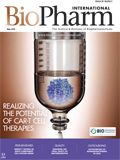Advancing cell therapy safety
Two main safety issues have been identified in the early-phase clinical trials conducted to date for chimeric antigen receptor (CAR)-T cell therapies.
Two main safety issues have been identified in the early-phase clinical trials conducted to date for chimeric antigen receptor (CAR)-T cell therapies. Cytokine release syndrome (CRS) occurs in some patients, particularly those with high tumor loads, when the CAR-T cells expand rapidly and cause the release of large quantities of cytokines (interferon, interleukins, etc.) that can lead to low blood pressure and other problems that can be fatal if not treated. On-target, off-cancer toxicity can also occur when the CAR-T cells attack healthy cells due to the presence of similar antigens.
“The ability to regulate the activity of CARs and find new ways to proactively manage CRS is an area of research interest across academia and industry,” observes Eric Althoff, head of global media relations with Novartis. Present approaches to minimizing CRS include the use of lower initial doses for patients with greater tumor density to reduce the cancer load and combined treatment with cytokine blockers. “As we gain confidence with the efficacy of CAR-T cell therapies, they will be used to treat patients at a much earlier stage of disease, and thus there will be reduced likelihood of CRS due to the reduced presence of tumor cells,” notes Hyam “Hy” Levitsky, executive vice-president and chief scientific officer of Juno Therapeutics.
Because on-target, off-cancer toxicity in live patients is difficult to predict in the laboratory, initial tests in human beings are performed using low doses and careful monitoring. CAR-T cells are also being engineered to include safety switches via transduction of T cells with marker or suicide genes that allow for their selective destruction in the event of severe toxicity. “For example, CAR-T cells can be marked for destruction via expression of a ligand on the cell surface, such as a truncated epidermal growth factor receptor-like (tEGFR) protein or the synthetic RQR8 peptide. If severe toxicity is observed following administration of CAR-T cells, biologic drugs specific for tEGFR (e.g., cetuximab) or RQR8 (e.g., rituximab) can be administered, resulting in destruction of the marked CAR-T cells,” explains Bruce McCreedy, senior vice-president of cell therapy at Precision BioSciences. Another type of safety switch involves dimerization of a fusion protein consisting of a small-molecule drug binding domain with an apoptotic protein intermediate such as the iCasp9/AP1903 (Bellicum Pharmaceuticals). Administration of an inert small-molecule dimerizer induces activation of the apoptotic pathway, leading to selective death of the CAR-T cells.
Bispecific CAR-T cell constructs that express two CARs are also being evaluated to address on-target, off-cancer toxicity. The activity of these CAR-T cells can be amplified or inhibited upon binding of each CAR expressed on the surface of the T cell. For instance, according to McCreedy, a bispecific CAR-T cell that expresses an activating CAR specific for a tumor cell antigen and an inhibitory CAR that recognizes an antigen expressed on normal tissues can limit potential for on-target, off-tumor damage. “Both an activating and an inhibitory signal would be delivered upon binding to normal tissues if the tumor antigen-specific CAR is also engaged (e.g., due to cross-reactivity), whereas only an activating signal would be delivered to a tumor cell that lacks expression of the normal tissue antigen,” McCreedy says.
CAR-T cells are also being designed that include inducible expression and/or signaling capabilities such that upon administration, the CAR-T cell activity can be induced through the activity of an inducible promoter sequence incorporated into the CAR construct or by administration of a small-molecule drug that allows the CAR to be expressed at the cell surface or enhances activation of CAR-T cells upon binding of target tumor cells. “Inducible expression of the CAR or potentiation/attenuation of CAR-T cell activity using small molecule modulators may allow for better control of CAR-T activity in vivo with the goal of enhancing both the safety and efficacy of CAR-T therapies,” notes McCreedy. Many of these advanced CAR-T cell therapies are being evaluated in Phase I/II clinical trials.
Article DetailsBioPharm International
Vol. 29, No. 5
Page: 14
Citation: When referring to this article, please cite it as C. Challener, "Advancing cell therapy safety" sidebar to "Realizing the Potential of CAR-T Cell Therapies," BioPharm International 29 (5) 2016.

VERAXA and Voyager to Create Combined Business for Advancing Pipeline of Next-Gen Cancer Therapies
April 23rd 2025The proposed business combination would create a publicly traded, clinical-stage biopharmaceutical company that will focus on developing a pipeline of next-generation cancer therapies.
Thermo Fisher Opens Advanced Therapies Collaboration Center in California
April 18th 2025The 6000-square-foot facility will provide cell therapy developers the support they need to transition to CGMP manufacturing, and an expanded footprint of the new center is expected to open in Philadelphia later in 2025.